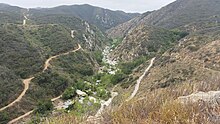Santa Margarita River
| Santa Margarita River Temecula River | |
|---|---|
 Mouth of the Santa Margarita River | |
| Location | |
| Country | United States |
| State | California |
| Physical characteristics | |
| Source | Confluence of Temecula Creek and Murrieta Creek |
| • location | Temecula, Riverside County |
| • coordinates | 33°28′27″N 117°08′26″W / 33.47417°N 117.14056°W[1] |
| • elevation | 950 ft (290 m) |
Camp Pendleton Marine Corps Base, San Diego County | |
• coordinates | 33°13′55″N 117°24′58″W / 33.23194°N 117.41611°W[1] |
• elevation | 7 ft (2.1 m)[1] |
| Length | 31 mi (50 km) |
| Basin size | 723 sq mi (1,870 km2) |
| Discharge | |
| • location | Ysidora |
| • average | 34.2 cu ft/s (0.97 m3/s) |
| • minimum | 0 cu ft/s (0 m3/s) |
| • maximum | 44,000 cu ft/s (1,200 m3/s) |
| Basin features | |
| Tributaries | |
| • left | Temecula Creek, Rainbow Creek, Pueblitos Canyon |
| • right | Murrieta Creek, Sandia Creek, De Luz Creek, Wood Canyon, Newton Canyon |
The Santa Margarita River which with the addition of what is now
History
The
In 1881 the California Southern Railroad followed the route of the river.[4] When the route was completed, it had 241 bridges crossing the river.[5] While it was operating, Chinese Americans worked on the railroad.[6] The route along the river was abandoned in 1891.[7]
In the early 20th century, following a lawsuit against Vail Ranch in
Watershed and course

The mainstem of the Santa Margarita River begins at the confluence of
Draining 1,922 square kilometres (742 sq mi), the Santa Margarita Watershed is the second largest river basin on the Southern California coastal plain.[13] The upper watershed consists of the 575 square kilometres (222 sq mi) Murrieta Creek subwatershed and the 948 square kilometres (366 sq mi) Temecula Creek subwatershed. Although there are two dams in the upper watershed, both dams must release water that roughly corresponds to natural flows in the tributaries that they are on. As a result, the flow of water in the Santa Margarita River is very close to what it would be in the absence of those two dams.[14]
Below the confluence of Murrieta and Temecula Creeks, the primary tributaries of the Santa Margarita River mainstem are Rainbow Creek on the left (headingdownstream) and Sandia Creek and De Luz Creeks on the right. The two latter creeks drain the Santa Rosa Plateau.[15]
Conservation and ecology
Approximately 4,334 acres (1,754 ha) of the middle course of the Santa Margarita River in Temecula Canyon are managed by
Approximately 70 species of special concern (rare, threatened, or endangered) regularly inhabit the watershed, including 30 that are currently protected under the
Major fishes in the Santa Margarita River include the
Major riparian plants include arroyo, black, narrowleaf, Pacific, and red willow (Salix spp);
References
- ^ a b c "Santa Margarita River". Geographic Names Information System. United States Geological Survey, United States Department of the Interior.
- ^ U.S. Geological Survey. National Hydrography Dataset high-resolution flowline data. The National Map, accessed March 16, 2011
- ^ Erwin G. Gudde (1960). California Place Names: The Origin and Etymology of Current Geographical Place Names. Berkeley, California: University of California Press. p. 296. Retrieved 2013-02-10.
santa margarita river gudde place names.
- ^ Braymer, Noel T. (5 April 2013). "The Railroad Destroying Santa Margarita River". Rail Passenger Association of California and Nevada. Retrieved 13 May 2018.
Ammenheuser, Maura (16 April 2011). "A Look Back: Railroad struggled in Temecula area". Press-Enterprise. Riverside, California. Retrieved 13 May 2018. - ^ a b Johnson, Gordon (2 May 2014). "Johnson: There once was a train ..." Press-Enterprise. Riverside, California. Retrieved 13 May 2018.
- ^ Scharf, Thomas L.; Griego, Andrew, eds. (Fall 1979). "Rebuilding the California Southern Railroad: The Personal Account of Chinese Labor Contractor, 1884". The Journal of San Diego History. 25 (4). Retrieved 13 May 2018.
- ^ Schad, Jerry (6 April 2006). "Trace the remnants of an old railroad grade along the bank of North County's Santa Margarita River". San Diego Reader. Retrieved 13 May 2018.
- ^ Stetson Engineers Inc. (27 April 2012). Southern California Steelhead Passage Assessment Lower Santa Margarita River, California and CUP Surface Water Availability Analysis (PDF) (Report). United States Bureau of Reclamation. pp. 1–10. Retrieved 13 May 2018.
- ^ Jones, J. Harry (12 December 2017). "Water-rights lawsuit ends after 66 years". San Diego Union-Tribune. Retrieved 13 May 2018.
- ^ Jones, J. Harry (30 August 2018). "Santa Margarita River property to be sold to a wildland conservancy; trails will remain open". San Diego Union-Tribune. Retrieved 8 September 2018.
- ^ a b "Temecula Creek". Geographic Names Information System. United States Geological Survey, United States Department of the Interior.
- ^ "Murrieta Creek". Geographic Names Information System. United States Geological Survey, United States Department of the Interior.
- ^ S2CID 45700231.[permanent dead link]
- ^ "Santa Margarita Ecological Reserve". San Diego State University. Retrieved 2013-02-10.
- ^ Katherine Shapiro (1997) [1991]. Refuge in an Urbanizing Land. The Santa Margarita River: Cultural and Natural Resource Value. Fallbrook, California: Santa Margarita River Foundation.
- ^ John Heil (January 7, 2022). "Pacific lamprey found in Santa Margarita River, for the first time in decades". U.S. Fish and Wildlife Service Pacific Southwest Region. Retrieved January 27, 2022.
- ^ ISBN 978-0-12-088253-3. Retrieved 2010-12-07.
- ^ Dick Newell, OCTrackers (2010). "Analyzing Beaver Track and Sign". Retrieved 2013-02-06.


